The Writers Workbench
by Robert J. Elisberg
More Power to You ?
May, 2013 ?
As mobile technology expands, so too does the need to run that technology. And that can mean using a gobsmack lot of batteries, which can mean a gobsmack lot of money to replace. As a result, a lot of people turn to rechargeable batteries as an alternative.
Perhaps the biggest problem over the years with rechargeable batteries has been that they don?t tend to hold their charge long after sitting around, so when you need to put in new batteries, there?s a bit of a lag, waiting to charge things back up to speed. A few years back, a new type of rechargeable battery was developed, low self-discharge batteries (LSD), also known as ?pre-charged rechargeable. They can be pre-charged and then packaged because they hold a charge very well. LSDs will hold an 85% charge for a year, and 70% over five years, though all this is when stored under perfect conditions. The point is that you can charge them at any time, and put them aside so they?ll be ready when you need them. Also, they can be recharged up to 1,000 times. Alas, I didn?t have a year (or five years) to check this out.
The best known and highest regarded batteries in this field is Eneloop developed by Sanyo, through there are many others, including white top Duracell, which have good reputations, AC Delco (offering a range of high and also low mAH-rated, the latter of which are best for slow charging rather than rapid), and Powerex which markets its own brand, Imedion.
Energizer, which makes an especially high-end, long-life brand of non-rechargeable Lithium batteries ? including its recently improved, Ultimate Lithium line ? also has branched into the rechargeable world with a range of chargers (more on them below), as well as rechargeable batteries themselves. Just know that despite what they say on their Web site, spokesmen for company say that the Energizer Recharge line got upgraded last fall and now come pre-charged and, like their competitors, hold 80% of their charge after a year.
POWEREX MH-C801D EIGHT CELL 1-HR CHARGER?
Amid the aforementioned batteries is a brand that might be unfamiliar, Powerex. I note them because Powerex also makes a brand of rechargers. After all, if you?re going to have rechargeable batteries, at some point you?re going to have to charge them.
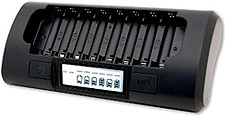 The Powerex MH-C801D (which also goes by the name Maha) is an impressive device in a field where you might think things should be pretty basic. Most notably, it comes with eight slots which can charge eight NiMH (Nickel Metal Hydride) or NiCad (Nickel Cadmium) batteries independently of one another, either AA or AAA. This is no small thing: most chargers will recharge only one battery size at a time. Further, they often require at least two batteries charging before the device will start. This latter is a particular problem, since a weaker battery will affect the charge of the other, because they share a single circuit. (Besides, you might only have one battery to charge.) The Powerex can charge one battery at a time, and it can also charge different combinations of sizes, different start times, and mixed brands all at the same time. That?s because each slot is on its own circuit.
The Powerex MH-C801D (which also goes by the name Maha) is an impressive device in a field where you might think things should be pretty basic. Most notably, it comes with eight slots which can charge eight NiMH (Nickel Metal Hydride) or NiCad (Nickel Cadmium) batteries independently of one another, either AA or AAA. This is no small thing: most chargers will recharge only one battery size at a time. Further, they often require at least two batteries charging before the device will start. This latter is a particular problem, since a weaker battery will affect the charge of the other, because they share a single circuit. (Besides, you might only have one battery to charge.) The Powerex can charge one battery at a time, and it can also charge different combinations of sizes, different start times, and mixed brands all at the same time. That?s because each slot is on its own circuit.
(NOTE: when charging more than one battery, the company says to insert them from left to right with no empty slots in between. The right side of the charger gets hotter than the left.)
The C801D is a "smart" charger. Batteries will automatically get a high charge when inserted, and as the battery gets fully charged, the device lowers to a trickle charge. And when charged, it stops.
The device will do either a rapid charge, or soft charge, but it can also deep condition batteries. (More on that later.) As a general rule, rapid charging will take one hour, with soft charging done in two hours. Time is flexible, of course, depending on a variety of conditions. Know that rapid charging can potentially lower the life of a battery because it runs hotter, and heat will reduce a battery?s life, though degradation should be minimal, maybe 10%. This loss is offset by the time saved by the faster charge. Soft charging works at a cooler temperature. Given that the soft charging process is pretty fast with the unit, it would seem that it?s the best way to go, unless you?re in a specific rush.
By default, the unit begins charging at its highest level, rather than requiring you to press a "Rapid Charge" option like many fast chargers. Upon detecting an inserted battery, it quickly does a check for how much power is in the battery, and then starts charging. If you?d rather do a slower, soft charge, you press the button labeled ?Soft? within five seconds of putting the batteries in. Given that soft charges might be better unless there?s a rush, it might have been preferable to have that the default mode, though it?s not a big issue. Regardless, whatever mode you?re in ? rapid or soft charge ? the device will charge at that mode for all the batteries currently inserted.
(Note: The C801D rapid charges at a rate of 2000 mAh for AA batteries, and 700 mAh for AAA. Therefore, you should only use the rapid charge mode on batteries that can handle this high current. That will be, of course, if AA batteries are rated at 2000 mAh capacity or higher, and with AAA batteries rated 700 mAh or higher. Otherwise, if the batteries are rated lower, you should always use the slower, soft charging. Battery packages will always give the rating.)
The aforementioned deep conditioning feature is generally used for batteries that have been lying around for a long time and might have lost their charge capacity. It?s also an issue for older Nickel Cadmium (NiCd) batteries you may still have around, rather than today?s current Nickel Metal Hydride (NiMH) ones. Conditioning will restore batteries to their optimal state. (This can take up to 14 hours, if the battery is in good enough shape to still hold a full charge, though if the battery no longer can hold a full charge, the process will take less time.) To condition problem batteries, you similarly press the ?conditioning? button within the first five seconds of inserting the batteries. Although not necessary with NiMH batteries, it?s still a good idea to recondition them every once in a while. This can probably give them more years of service.
 The C801D has an LCD display that provides much more information for each battery?s status than the typical green/red ?charging? light. When it shows one bar, that means your battery has a 0-50% charge, two displayed bars are 50-80%, and 3 bars means the charge is 80-100% completed. When the word ?Done? is displayed, the battery is fully charged. In addition, an empty battery icon with no bars means that your battery has to be conditioned first. (As noted, that?s usually very old batteries that have been sitting around.) Flashing bars means there?s a battery fault. The LCD is quite convenient, though not being backlit, the icons or text can sometimes be difficult to read.
The C801D has an LCD display that provides much more information for each battery?s status than the typical green/red ?charging? light. When it shows one bar, that means your battery has a 0-50% charge, two displayed bars are 50-80%, and 3 bars means the charge is 80-100% completed. When the word ?Done? is displayed, the battery is fully charged. In addition, an empty battery icon with no bars means that your battery has to be conditioned first. (As noted, that?s usually very old batteries that have been sitting around.) Flashing bars means there?s a battery fault. The LCD is quite convenient, though not being backlit, the icons or text can sometimes be difficult to read.
There are several other nice features. The most important of these is probably its Integrated Safety Protection. This prevents non-rechargeable Alkaline batteries from being inserted (a very good thing, since they have the potential to explode if charged?) and keeps you from incorrectly putting in a battery backwards with the polarity reversed, that blocks the device from accepting a charge. Also, the feature guards against short circuits.
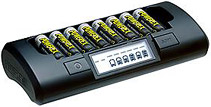 Being microprocessor controlled, the C801D can detect very small voltage differences within 0.001V, allowing a battery to receive an accurate charge. This is what charges batteries to their maximum capacity without overcharging or undercharging.
Being microprocessor controlled, the C801D can detect very small voltage differences within 0.001V, allowing a battery to receive an accurate charge. This is what charges batteries to their maximum capacity without overcharging or undercharging.
Nice, too, is that its cord is a Universal worldwide AC power adapter, so it can use foreign current and not require a transformer. You can buy adapter plugs for international usage, though the company itself makes inexpensive power cord adapters (around $7). As a result, the MH-C801D will charge batteries anywhere around the world, in case you choose to carry it with you on your travels. Two quibbles: you must unplug the device when not using it, because there?s no on/off switch. And also the cord to the power block is a bit short (around 16?), making it a little inconvenient to run the charger on a desk with the power block on the floor.
The Powerex MH-C801D costs more than basic units you can commonly find. It retails for $100 at the time of writing, though can be found for $65 online. However, if you do more than just rare recharging of batteries, its many features may be well worth the added cost in the long run.
RECHARGE UNIVERSAL?
As mentioned, Energizer has a wide line of chargers, along with its rechargeable batteries. The Universal model can charge all sizes of batteries (AA, AAA, C, D and 9V). There are four bays, each allowing for one or two batteries, depending on the size. (For example, it can charge up to 8 AA?s.) Each battery is detected individually with its own charging light. And you can also charge different size batteries at the same time, a very good thing. A nice protective feature is that it won?t charge until the lid is close. And an LCD screen shows the charging status in each of the individual charging bays.
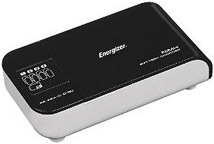 The Universal is a ?smart? charger, so it can detect when a battery is full and will automatically stop charging. It also won?t charge if a battery is bad. The charger won?t condition batteries, though, as noted above, that?s not really an issue with today?s NiMH batteries.
The Universal is a ?smart? charger, so it can detect when a battery is full and will automatically stop charging. It also won?t charge if a battery is bad. The charger won?t condition batteries, though, as noted above, that?s not really an issue with today?s NiMH batteries.
The charger generally does a fairly good job on batteries which are holding different charges, although it seemed to do so a little inconsistently. Importantly, however, documentation says that the charger is optimized for Energizer brand batteries, and it appears to be quite temperamental on different brands, so if you tend to use non-Energizer that could be an issue.
Times will differ, but it generally rapid charges batteries in about three hours, and takes seven hours on soft, so it?s not the swiftest charger you?ll find. This is hardly ideal, but not really a problem for most people. First of all, rapid charging runs hotter and will shorten the life of your batteries, so people may prefer to just slow charge batteries anyway, like overnight. And since rechargeables hold their charge pretty well today, you?ll likely have a spare handy in case there is an emergency. As above with the Universal charger, it doesn?t condition batteries, but that shouldn?t be an issue for most people.
The charger works with an AC transformer, and also works with universal voltage, so you can take it on your travels as a world charger (though of course you?ll need to get adapter plugs.)
On the plus side, the Energizer Universal does a respectable job charging, has some good ?smart? features, can be used for world travel, is very portable and inexpensive. The cons are that it works best with Energizer-only batteries (and may be problematic with other brands) and is somewhat slow.
At the time of writing, the Energizer Universal can be found for $25.88.
ENERGIZER RECHARGE RAPID?
The Energizer Recharge Rapid doesn?t do as many things as the Universal, but focuses well on fast charging. It can hand either AA or AAA batteries, up to four at a time, and will also charge ?widows? ? a single battery or three. It also won?t allow you to insert batteries with the wrong polarity.
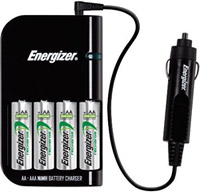 As a smart charger, it uses trickle charging, so that you can?t overcharge. In addition, slots work independently, meaning (as noted) you can charge an odd numbers batteries at the same time. A ?bad battery? detector will inform you if there?s a problem with one, though it seemed a bit sensitive and found blocked some batteries that charged elsewhere.
As a smart charger, it uses trickle charging, so that you can?t overcharge. In addition, slots work independently, meaning (as noted) you can charge an odd numbers batteries at the same time. A ?bad battery? detector will inform you if there?s a problem with one, though it seemed a bit sensitive and found blocked some batteries that charged elsewhere.
Charging, as befits its name, is quite fast. Though times vary, it basically takes 15 minutes to charge two batteries, and 30 minutes for three or four. However, they suggest leaving battery in for an additional 10 minutes after charging because the batteries can get hot. (And again, as noted, rapid chargers are more damaging to a battery?s life cycle.) There is a built-in cooling fan.
Although there is a light that informs you of the charging status, it?s only a single light. So, if the light blinks to indicate a bad battery, you have to take them out one at a time to check. Also, as with all Energizer chargers, it is optimized for Energizer Recharge batteries, and doesn?t always play as nice with other brands. Know, too, that it won?t condition batteries, though as you?ve likely figured out by now, that?s not really an issue with today?s NiMH batteries.
It comes with an AC adapter, as well as a handy car adapter plug. Plus, it has universal voltage, so it can be taken abroad (though you?ll need to get adapter plugs.)
Among the benefits of the Recharge Rapid are that it?s very fast, has several helpful ?smart features, can charge odd-numbered batteries, is very portable, usable for world travel and inexpensive. On the negative side, it?s limited to AA and AAA batteries, has no soft charging, and doesn?t work as well with non-Energizer batteries.
At the time of writing, it can be found for $29.71. It comes with four AA batteries.
ENERGIZER RECHARGE SMART?
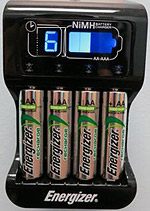 The Recharge Smart is a basic charger that adds in some helpful features. For instance, it has an LCD indicator that shows the charge status, as well as a Countdown timer with a large display for how much time is left. The Bad Battery Alert detects batteries upon installation that won?t recharge and will then shuts down charger. There is a built-in wall plug, so it doesn?t need an AC adapter. It accepts AA or AAA batteries, and charges two or four at a time.
The Recharge Smart is a basic charger that adds in some helpful features. For instance, it has an LCD indicator that shows the charge status, as well as a Countdown timer with a large display for how much time is left. The Bad Battery Alert detects batteries upon installation that won?t recharge and will then shuts down charger. There is a built-in wall plug, so it doesn?t need an AC adapter. It accepts AA or AAA batteries, and charges two or four at a time.
Unfortunately, it can only charge batteries in pairs. Also, the Countdown timer isn?t especially effective, and the company states that it can take up to a half hour to get an accurate reading. The Battery charge gauge will display up to four bars for the four slots, which is good, but there?s only a single gauge per slot ? so if you have two batteries in a slot, the gauge controls them both. It also seems to default to the lower-charged battery, which means the other battery can be overcharged.
The devices charges batteries in about 7 hours. It does use universal voltage, so it can be taken on trips for world travel.
The Recharge Smart is inexpensive, very portable and can be used for world travel. However, it?s slow, can?t charge odd-number batteries, and doesn?t work well with non-Energizer brand batteries.
The Recharge Smart can be found for $15.33 at time of writing. It comes with four AA batteries.
TWW Notes?
- Previously, Verizon Wireless users had to wait 20 months before they could get an early upgrade on their cell phones. The company recently announced that they?re changing that to 24 months. Given that contracts are for 2-years, it would seem to eliminate the concept of ?early? upgrade. In a bit of whimsical writing, Verizon?s press statement also said, ?As always, customers may purchase a new phone at the full retail price at any time.? As opposed, apparently, to people thinking that the company wouldn?t sell them a phone at full price.
- On the other side of the cell phone coin, T-Mobile announced that it would be getting rid of contracts entirely, but also would be dropped subsidized pricing of phones. Users would put money down for the phone and pay a monthly fee for a set period. However, once the phone is paid off, it belongs to the users and the monthly payment for it would disappear. T-Mobile also said it would be now selling the iPhone.
- Battery technology has always been a challenge to improve, because of the basic realities of things like physics. However, scientists at the University of Illinois have made encouraging advances. They?ve developed a teensy, lithium ion, micro-battery, just millimeters in thickness that can not only charge a car battery, but can be recharged itself in less than one second! (It has to do with redesigning the cathode and anode poles on a battery.) It?s able to recharge at 1,000 times faster than what can be done now. Hold on for the time being, though ? because of its size it?s not available yet for being incorporated into devices for public consumption. But obviously that?s something they?re working on.
Note: The Writers Guild of America, West neither implicitly nor explicitly endorses opinions or attitudes expressed in this article.?
Copyright 2013, Robert J. Elisberg. All rights reserved.?
Robert J. Elisberg?has written about computers for such publications as C/NET, PC Games, CD-ROM Today, Yahoo! Internet Life, E! Online and Hollywood Screenwriter. He also writes writes a regular column for the Huffington Post. A screenwriter, he served for five years as a member of the WGA, West website editorial board and Editorial Advisory Committee.
?
Source: http://www.wga.org/content/default.aspx?id=5237
oscar nominations C7 Corvette tom brady denver post Scandal denver broncos new england patriots
No comments:
Post a Comment
Note: Only a member of this blog may post a comment.